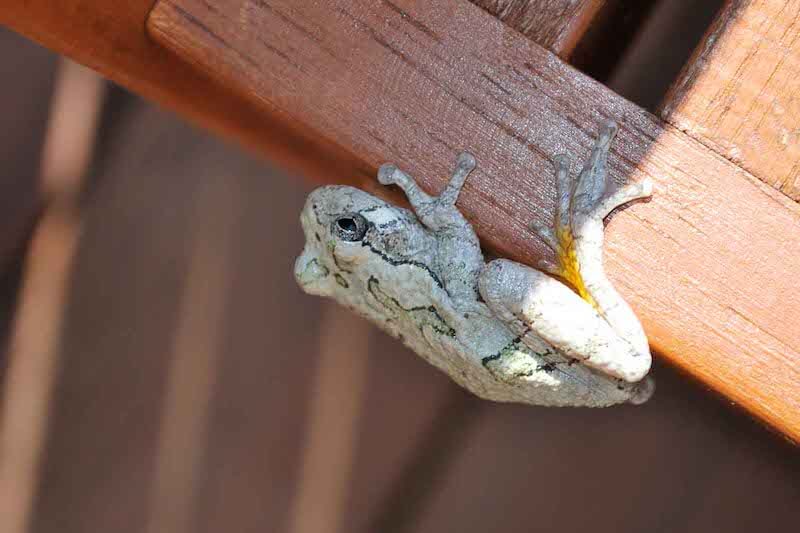Tree frogs are found throughout most of North America, and you’ll find 6 species of tree frogs in Minnesota. These little frogs are quite small, excellent climbers, and usually stay up in the trees well-hidden and camouflaged. They can be quite vocal and loud in the spring and summer, so even though you can’t see them you’ll know they’re around.
All tree frogs start their lives in the water as tadpoles, so we know that most tree frogs live their lives in proximity to a body of water. It just so happens that 6% of Minnesota is water, that’s more than any other state. This much water creates plenty of habitats for aquatic and semi-aquatic wildlife, including frogs like the tree frogs on this list.
With all that being said, let’s dive into this list of Minnesota treefrogs.
6 types of tree frogs in Minnesota
The 6 species of tree frogs in Minnesota are the gray tree frog, Cope’s gray tree frog, Blanchard’s cricket frog, spring peeper, boreal chorus frog, and the western chorus frog.
1. Eastern gray treefrog

Scientific name: Dryophytes versicolor
The eastern gray tree frog is probably one of the most common tree frogs in Minnesota and the eastern half of the United States. They can be found from Eastern Oklahoma all the way to the Atlantic Ocean, including most of Minnesota.
While they are named for their normal gray color, these little guys are able to change their colors to blend into their environments. So you may encounter one that has gray, brown, or green coloring Eastern gray tree frogs are small and only reach around 2 inches in length as adults.
They feed primarily on insects, spiders, slugs, and snails, but have been known to eat smaller frogs. These nocturnal frogs are active starting at around dusk when you’ll hear the male’s mating call which can last for hours.
Once a mate is found, thousands of eggs will be fertilized and eventually the tadpoles will be born. It typically takes 45-65 days for the metamorphosis into frogs to complete. The frogs will be sexually mature by 2 years old. Eastern gray tree frogs live for 7-9 years.
2. Cope’s gray treefrog
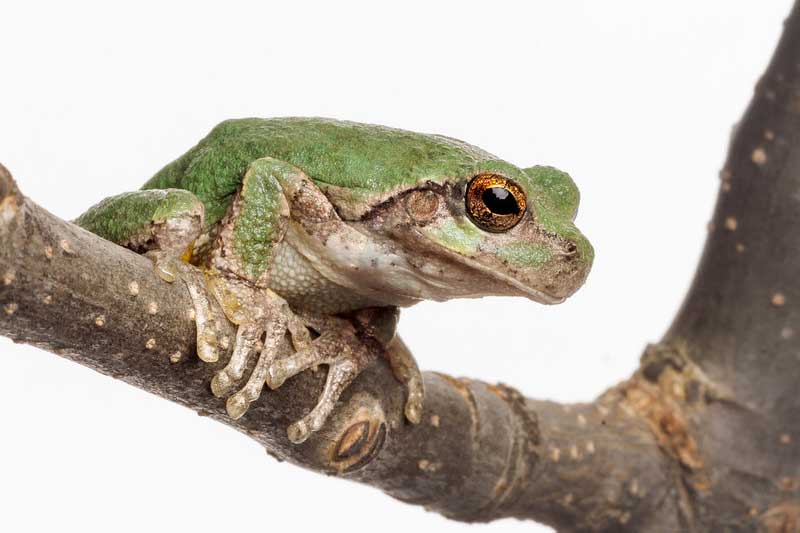
Scientific name: Dryophytes chrysoscelis
The Cope’s gray tree frog occurs in parts of Minnesota though it’s unclear how prevalent they are in the state. They are also known as the southern tree frog, and in appearance they are almost identical to the eastern gray tree frog.
You can begin hearing the mating calls of this species around the same time as others, in April and May. While these frogs are called tree frogs and are actually commonly seen in trees, mating and egg fertilization occurs on the ground near water.
The males climb up into the tree and make their mating calls high off the ground so the sound can travel and they have a better chance of finding a mate. They are about the same size as eastern gray tree frogs, are rarely seen on the ground. Cope’s tree frogs often live near swamps or marshes, but also in prairies, meadows, fields, and forested areas near bodies of water.
3. Blanchard’s cricket frog
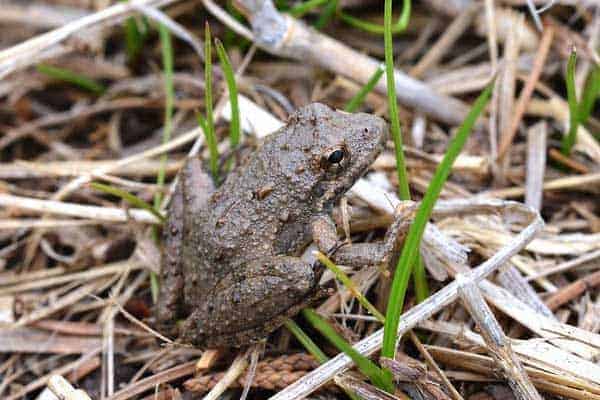
Scientific name: Acris blanchardi
The Blanchard’s cricket frog is another small tree frog of the family Hylidae, and are known as the most aquatic tree frogs in North America. They’re found in many midwestern U.S. states from Texas to Southern Michigan, Wisconsin, and even extreme Southern Minnesota where they’re threatened or endangered. They only reach about 1.5 inches in length as adults and are usually found near ponds, lakes, and slow moving bodies of water.
Because of their mostly aquatic tendencies, they will always be close to water and are actually considered non-climbing tree frogs. They are typically tan, brown, gray, or olive green in appearance. These frogs come out of hibernation each year in late March or early April. Like other small tree frogs in Minnesota, they feed on small invertebrates like insects, arachnids, and snails.
4. Northern spring peeper
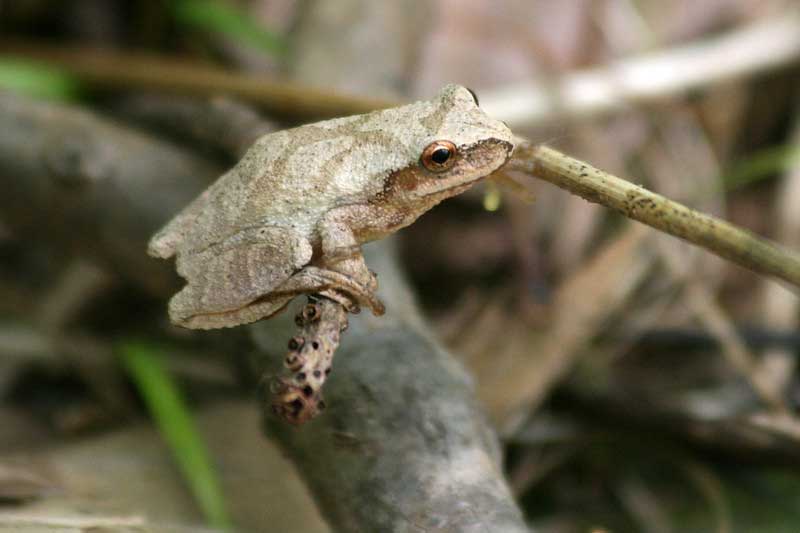
Scientific name: Pseudacris crucifer
The northern variety of the spring peeper can be found throughout the eastern half of the United States, including Eastern and Northeastern Minnesota. These tiny tree frogs only grow to about an inch in length as adults, but they make up for their size with their big voices.
Like other tree frogs and chorus frogs, it’s the males that are so loud with their mating calls. If you’re close to a male spring peeper, their sound can reach about 90 decibels, which is about as loud as a lawnmower. A rock concert is about 120 decibels for comparison.
If you hear a chorus of spring peepers, even from a distance it’s still going to be in the 60-70 decibel range. Adult spring peepers come out in the late afternoon and early evenings to feed on a variety of small insects and invertebrates.
They begin breeding in the early spring and females will lay 750-1200 eggs submerged, attached to aquatic vegetation. The tadpoles will emerge in a week or two and turn into frogs within another 6-12 weeks.
5. Western chorus frog
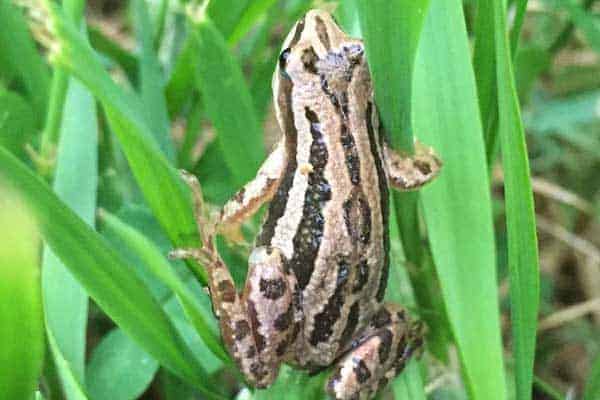
Scientific name: Pseudacris triseriata
The western chorus frog is a common tree frog in Minnesota and common throughout southern parts of the state. They’re found throughout much of the midwest and eastern United States. South of Arkansas, Illinois, and Indiana, you’ll find the upland chorus frog.
Western chorus frogs are probably the smallest tree frogs in Minnesota, and one of the smallest in the country. As adults they are sometimes less than an inch in length. They prefer living near wooded areas, ponds, marshes, wetlands, or slow moving bodies of water.
The color varies and may be anywhere from greenish gray to brown. You can identify them by the 3 dark stripes going down their backs and their small size. They are very difficult to distinguish from boreal frog that’s up next. Though it’s believed that the western variety has longer legs.
6. Boreal chorus frog

Scientific name: Pseudacris triseriata maculata
The boreal chorus frog is a subspecies of the western chorus frog. These tiny frogs are quite common throughout Minnesota and occur everywhere in the state.
These frogs are brown, reddish, tan, gray or olive in color with 3 dark stripes along their backs. They’re about 1.5 inches in length as adults and their range does overlap with the western chorus frog in some places. The boreal variant is much more common in Canada than it’s cousin.
